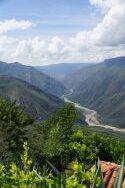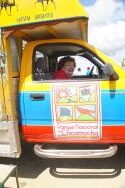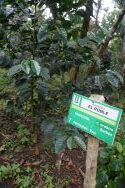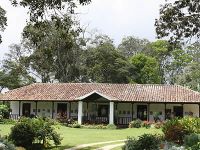Big bottomed ants, a virgin, and tropical dry forest add up to “the most beautiful city in Colombia”
January 6, 2018.
If you look at the CIA World Fact book, as I did, you’ll get an idea of the expanse of Colombia. Superimposing a Colombian map on the United States stretches the country the length of the Mississippi River, from Minneapolis to New Orleans. While we’ve sampled only a small part of it (we’re only 150 air miles from Bogota), but that includes a wide variety of habitats and a lot more than the 150 miles through the mountains. We’ve left the savanna behind in favor of high desert and canyons (and a 30 minute plane ride or 8 hour automobile ride back to Bogota, which says something about the transportation system). There are only a few “third generation” roads—six lane highways, and the road here, probably second generation, is a two-lane toll road that goes through every town, roughly following the ridges. As we’ve lost elevation, though still at around 4500 feet, we’ve passed through banana, orange, and coffee farms. The big product here, though, was tobacco.
Two things about that crop: first, it required sunshine, which mean most of the existing trees were cut down. The brochure on Barichara, where we’re staying in a charming boutique hotel, Moorish/Spanish style, says the tropical dry forest is the most endangered ecosystem of all, with only 2% remaining pristine. Tobacco and other agricultural pursuits have had a hand in that environmental change.
Second, the tobacco industry has declined, with the purchase of the local manufacturer by the British American Tobacco conglomerate. One result was a rather imaginative conversion of the old tobacco plant to a mall, with the foreman’s house converted to a museum. The  exhausted tobacco lands need banned fertilizers to be productive again. The second-rate tobacco still produced here is for local consumption.
exhausted tobacco lands need banned fertilizers to be productive again. The second-rate tobacco still produced here is for local consumption.
The current “cash crop,” however, is tourism, based around the 8000 population in Barichara.
Legend has it that a peasant here around 1700 found a rock with the image of the Virgin, and convinced his friends to build a church, around which the town grew. The local clergy, however, condemned this as idolatry, destroyed the church, and built a “purified one” on the site in the mid 18th century. That church still stands, anchoring the square (which unlike Villa de Leyva has trees) that was and is the center of life in Spanish colonies.
peasant here around 1700 found a rock with the image of the Virgin, and convinced his friends to build a church, around which the town grew. The local clergy, however, condemned this as idolatry, destroyed the church, and built a “purified one” on the site in the mid 18th century. That church still stands, anchoring the square (which unlike Villa de Leyva has trees) that was and is the center of life in Spanish colonies.
The town is full of colonial and republican period homes, white adobe, housing the usual knick-knacks—like indigenous-themed jewelry and textiles, specialty coffees and chocolates, restaurants and hotels. Eight thousand inhabitants live here, too. Surprisingly, you don’t see any modern construction in the city proper; the red tiles of the roofs and the hilly nature of the town provide part of the charm.
When we went for a walk to explore what there was, two visits stood out. One was a culture house, which local people created with a variety of gifts—art, cultural artifacts—and the docent who took us around shared a lot of information about the town.
The other visit was to the Paper Museum. It’s an NGO operation designed to provide gainful employment to women. The museum grows a variety of plants that can be turned into paper (did you know pineapple can be made into paper?), gives tours, and creates a variety of paper products for sale. I really liked the lampshades, but I’m certain I’d have shreds if I tried to bring one back.
The town overlooks a deep valley, and the upper part of the town is where one finds the inevitable Liberator statue. What I learned there is that the Boyaca battle ended the war for Colombian independence. There were battles fought to liberate the other countries (the five were Colombia, Bolivia, Ecuador, Peru, and Venezuela; I had listed Panama, but that country did not exist until Theodore Roosevelt helped convince revolutionaries there to separate it from Colombia around 1905 so the US could build the Panama Canal).
It was on that walk we purchased the fried big-bottomed ants that are considered a local delicacy. The “princesses” are captured as they attempt to fly out of the nest to start new colonies, deprived of wings, and roasted.
Supposedly, the ants date back to the indigenous Guane people who inhabited this area from about 1000 a.d. until they were assimilated (or annihilated) by the Spanish. Relatives of the Muisca, they were reputedly taller and lighter-skinned than their neighbors.We learned more about the Guane today at a museum at what purported to be a National Park, which turned out to be a private park. 
 Located at a breathtaking canyon that drops over 3000 feet (“Gran Canon” in local advertisements), the park had a water park, bungee jumping, a zip line, and the second longest cable car ride in the world. We took the last named, which dropped 2500 feet or so to the floor, then went up about 3500 feet to the other side, where we spent an hour wandering among the live traditional entertainers, local foods, and tchotchkes.
Located at a breathtaking canyon that drops over 3000 feet (“Gran Canon” in local advertisements), the park had a water park, bungee jumping, a zip line, and the second longest cable car ride in the world. We took the last named, which dropped 2500 feet or so to the floor, then went up about 3500 feet to the other side, where we spent an hour wandering among the live traditional entertainers, local foods, and tchotchkes.
So if you want to eat ants (another local delicacy I tried was a mixture of goat intestines) and stay in what was voted the most beautiful old Spanish village in Colombia, you have to come to Barichara. Like we did.
The next day—the ride to Bucaramanga duplicated part of the previous day’s ride through the mountains on a two-lane toll road, but 
 detoured to visit a coffee farm. The company, Hacienda de Roble, has been in business for over 150 years. Coffee grown for export has to meet strict standards. Like tobacco, certain soils and weather are important for growing the crop. A lesser brand, apparently not meeting global tastes, is sold locally. We got to taste four main varieties (there are over 300 different varieties of coffee), and I thought it was easier to tell the difference between the $5 Port and the $50 Port than to distinguish varieties of coffee, which can be even more costly than expensive Port. The farm has a garden with supposedly 72 varieties of coffee, mostly variants of Arabica (you can tell by the name it’s not native to Colombia), fertilized by chicken manure…..Ask for HR-61 if you want to try a coffee developed at the farm.
detoured to visit a coffee farm. The company, Hacienda de Roble, has been in business for over 150 years. Coffee grown for export has to meet strict standards. Like tobacco, certain soils and weather are important for growing the crop. A lesser brand, apparently not meeting global tastes, is sold locally. We got to taste four main varieties (there are over 300 different varieties of coffee), and I thought it was easier to tell the difference between the $5 Port and the $50 Port than to distinguish varieties of coffee, which can be even more costly than expensive Port. The farm has a garden with supposedly 72 varieties of coffee, mostly variants of Arabica (you can tell by the name it’s not native to Colombia), fertilized by chicken manure…..Ask for HR-61 if you want to try a coffee developed at the farm.
What impressed Carolyn was the Hacienda. Built by a woman artist in the  1860s, and now a boutique hotel, it’s in the Spanish colonial style. Set on the Mesa de los Santos, at roughly a mile high, the house would make for a comfortable stay. No wonder Carolyn said our next trip should be to visit other haciendas.
1860s, and now a boutique hotel, it’s in the Spanish colonial style. Set on the Mesa de los Santos, at roughly a mile high, the house would make for a comfortable stay. No wonder Carolyn said our next trip should be to visit other haciendas.
Time to go home to our own villa, though. No more mesas, mountains, or colonial villages. Sigh.